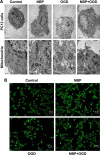3- n-butylphthalide exerts neuroprotective effects by enhancing anti-oxidation and attenuating mitochondrial dysfunction in an in vitro model of ischemic stroke
- PMID: 30587922
- PMCID: PMC6298396
- DOI: 10.2147/DDDT.S189472
3- n-butylphthalide exerts neuroprotective effects by enhancing anti-oxidation and attenuating mitochondrial dysfunction in an in vitro model of ischemic stroke
Abstract
Purpose: This study examined whether the neuroprotective drug, 3-n-butylphthalide (NBP), which is used to treat ischemic stroke, prevents mitochondrial dysfunction.
Materials and methods: PC12 neuronal cells were pretreated for 24 hours with NBP (10 μmol/L), then exposed to oxygen and glucose deprivation (OGD) for 8 hours as an in vitro model of ischemic stroke. Indices of anti-oxidative response, mitochondrial function and mitochondrial dynamics were evaluated.
Results: OGD suppressed cell viability, induced apoptosis and increased caspase-3 activity. NBP significantly reversed these effects. NBP prevented oxidative damage by increasing the activity of superoxide dismutase and lowering levels of malondialdehyde (MDA) and reactive oxygen species (ROS). At the same time, it increased expression of Nrf2, HO-1 and AMPK. NBP attenuated mitochondrial dysfunction by enhancing mitochondrial membrane potential and increasing the activity of mitochondrial respiratory chain complexes I-IV and ATPase. NBP altered the balance of proteins regulating mitochondrial fusion and division.
Conclusion: NBP exerts neuroprotective actions by enhancing anti-oxidation and attenuating mitochondrial dysfunction. Our findings provide insight into how NBP may exert neuroprotective effects in ischemic stroke and raise the possibility that it may function similarly against other neurodegenerative diseases involving mitochondrial dysfunction.
Keywords: ischemic stroke; mitochondrial dynamics; mitochondrial dysfunction; neuroprotective.
Conflict of interest statement
Disclosure The authors report no conflicts of interest in this work.
Figures






Similar articles
-
DL-3-n-butylphthalide prevents neuronal cell death after focal cerebral ischemia in mice via the JNK pathway.Brain Res. 2010 Nov 4;1359:216-26. doi: 10.1016/j.brainres.2010.08.061. Epub 2010 Aug 25. Brain Res. 2010. PMID: 20800583 Free PMC article.
-
DL-3-n-butylphthalide protects endothelial cells against oxidative/nitrosative stress, mitochondrial damage and subsequent cell death after oxygen glucose deprivation in vitro.Brain Res. 2009 Sep 22;1290:91-101. doi: 10.1016/j.brainres.2009.07.020. Epub 2009 Jul 16. Brain Res. 2009. PMID: 19616517
-
Theaflavic acid from black tea protects PC12 cells against ROS-mediated mitochondrial apoptosis induced by OGD/R via activating Nrf2/ARE signaling pathway.J Nat Med. 2020 Jan;74(1):238-246. doi: 10.1007/s11418-019-01333-4. Epub 2019 Jun 21. J Nat Med. 2020. PMID: 31227974
-
New insights into targeting mitochondria in ischemic injury.Apoptosis. 2021 Apr;26(3-4):163-183. doi: 10.1007/s10495-021-01661-5. Epub 2021 Mar 9. Apoptosis. 2021. PMID: 33751318 Review.
-
A Systematic Review of Neuroprotective Efficacy and Safety of DL-3-N-Butylphthalide in Ischemic Stroke.Am J Chin Med. 2019;47(3):507-525. doi: 10.1142/S0192415X19500265. Epub 2019 Apr 9. Am J Chin Med. 2019. PMID: 30966774
Cited by
-
Effect of Dl-3-n-butylphthalide on mitochondrial Cox7c in models of cerebral ischemia/reperfusion injury.Front Pharmacol. 2023 Feb 22;14:1084564. doi: 10.3389/fphar.2023.1084564. eCollection 2023. Front Pharmacol. 2023. PMID: 36909178 Free PMC article.
-
DL-3-n-butylphthalide protects the blood-brain barrier against ischemia/hypoxia injury via upregulation of tight junction proteins.Chin Med J (Engl). 2019 Jun 5;132(11):1344-1353. doi: 10.1097/CM9.0000000000000232. Chin Med J (Engl). 2019. PMID: 30939485 Free PMC article.
-
CEBPA-AS1 Knockdown Alleviates Oxygen-Glucose Deprivation/Reperfusion-Induced Neuron Cell Damage by the MicroRNA 24-3p/BOK Axis.Mol Cell Biol. 2021 Jul 23;41(8):e0006521. doi: 10.1128/MCB.00065-21. Epub 2021 Jul 23. Mol Cell Biol. 2021. PMID: 34001648 Free PMC article.
-
Suppression of lncRNA SNHG15 protects against cerebral ischemia-reperfusion injury by targeting miR-183-5p/FOXO1 axis.Am J Transl Res. 2020 Oct 15;12(10):6250-6263. eCollection 2020. Am J Transl Res. 2020. PMID: 33194027 Free PMC article.
-
The Role of Nrf2 in Relieving Cerebral Ischemia-Reperfusion Injury.Curr Neuropharmacol. 2023;21(6):1405-1420. doi: 10.2174/1570159X21666221129100308. Curr Neuropharmacol. 2023. PMID: 36453490 Free PMC article. Review.
References
-
- Khoshnam SE, Sarkaki A, Rashno M, Farbood Y. Memory deficits and hippocampal inflammation in cerebral hypoperfusion and reperfusion in male rats: neuroprotective role of vanillic acid. Life Sci. 2018;211:126–132. - PubMed
MeSH terms
Substances
LinkOut - more resources
Full Text Sources
Medical
Research Materials

